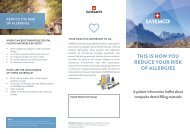SAREMCO Brochure | English | Without Classics | Digital Version
brochure_en_04-2024_singlepage_full_without_classics_digital
brochure_en_04-2024_singlepage_full_without_classics_digital
You also want an ePaper? Increase the reach of your titles
YUMPU automatically turns print PDFs into web optimized ePapers that Google loves.
APT ADVANCED POLYMER TECHNOLOGY
ONE STEP AHEAD WITH INNOVATIVE POLYMER TECHNOLOGY!
Degradation-stable polymers allow for fewer by-products and
thus better tolerability.
saremco apt composite based on a new SAREMCO MONOMER.
The monomer was developed within the framework of the
INNOSUISSE project in collaboration with the Swiss Universities
of Applied Sciences Freiburg and Sion (HES-SO). Compared to
established filling materials, saremco apt composite exhibits up
to 10 times reduced degradation due to enzymes in the saliva.
It is well known that methacrylate-based dental plastic materials
are broken down by enzymes.4) The by-products find their way
– more or less – uncontrolled into the human organism. These
processes have scarcely been examined to date and remain
completely beyond the influence of the dentist. In addition,
as a result of the weakening/erosion of the polymer through
degradation processes, other micro-organisms can invade the
filling and thus produce secondary caries.
ELUTION BEHAVIOR OF SAREMCO APT COMPOSITE
Analytical assessment «Elution behavior of a new SAREMCO
filling composite» 5)
Composite
Distilled water
Methanol
HEMA TEGDMA HEMA TEGDMA
apt composite n.d * n.d * n.d * n.d *
«Methacrylates are regarded as substances with high allergic
potential. The higher the number of elutable methacrylates and the
higher the amount of eluted methacrylates from dental materials,
the greater the probability that sensitive patients can develop an
allergy to it. With this new filling composite no methacrylate can be
detected either in aqueous or methanolic eluate.» 5)
*
n.d. = not detected
HIGH BIOLOGICAL TOLERABILITY OF THE SAREMCO MONOMER
In multiple studies by the Zurich University for Applied Sciences
(ZHAW) in Waedenswil, the interaction of human cells with
saremco apt composite 1) was examined. Osteoblasts (bone
cells), endothelial cells (vascular cells) and fibroblasts (connective
tissue cells) exhibit an optimal cell behavior regarding adhesion,
morphology and proliferation up to a clear differentiation after
14 days.
Day 1
Osteoblasts Fibroblasts Endothelial
Day 1 Day 1
Day 7 Day 7 Day 7
17
1)
Dr. Epifania Bono et. al. “In vitro characterization of a new composite material for biomedical applications an 3D (bio)printing”, Zurich University of Applied Sciences ZHAW; 11/2017
2)
Prof. Dr. Umberto Piantini, HES-SO Valais-Wallis, degradation measurements; 04/2017
3)
Prof. Dr. C.J. Kleverlaan, ACTA Academic Centre for Dentistry Amsterdam; 03/2018
4)
Delaviz Y., Finer Y., Santerre J. P., Biodegradation of resin composites and adhesives by oral bacteria and saliva: A rationale for new material designs that consider the clinical environment and treatment challenges.
Dental Materials 30 (2014) 16-32
5)
Univ.-Prof. Dr. Dr. Franz-Xaver Reichl, Polyclinic for Conservative Dentistry and Parodontology of the LMU and Walther Straub Institute for Pharmacology and Toxicology of the LMU, Nussbaumstr. 26, 80336 Munich,
www.dentaltox.com; 03/2018



